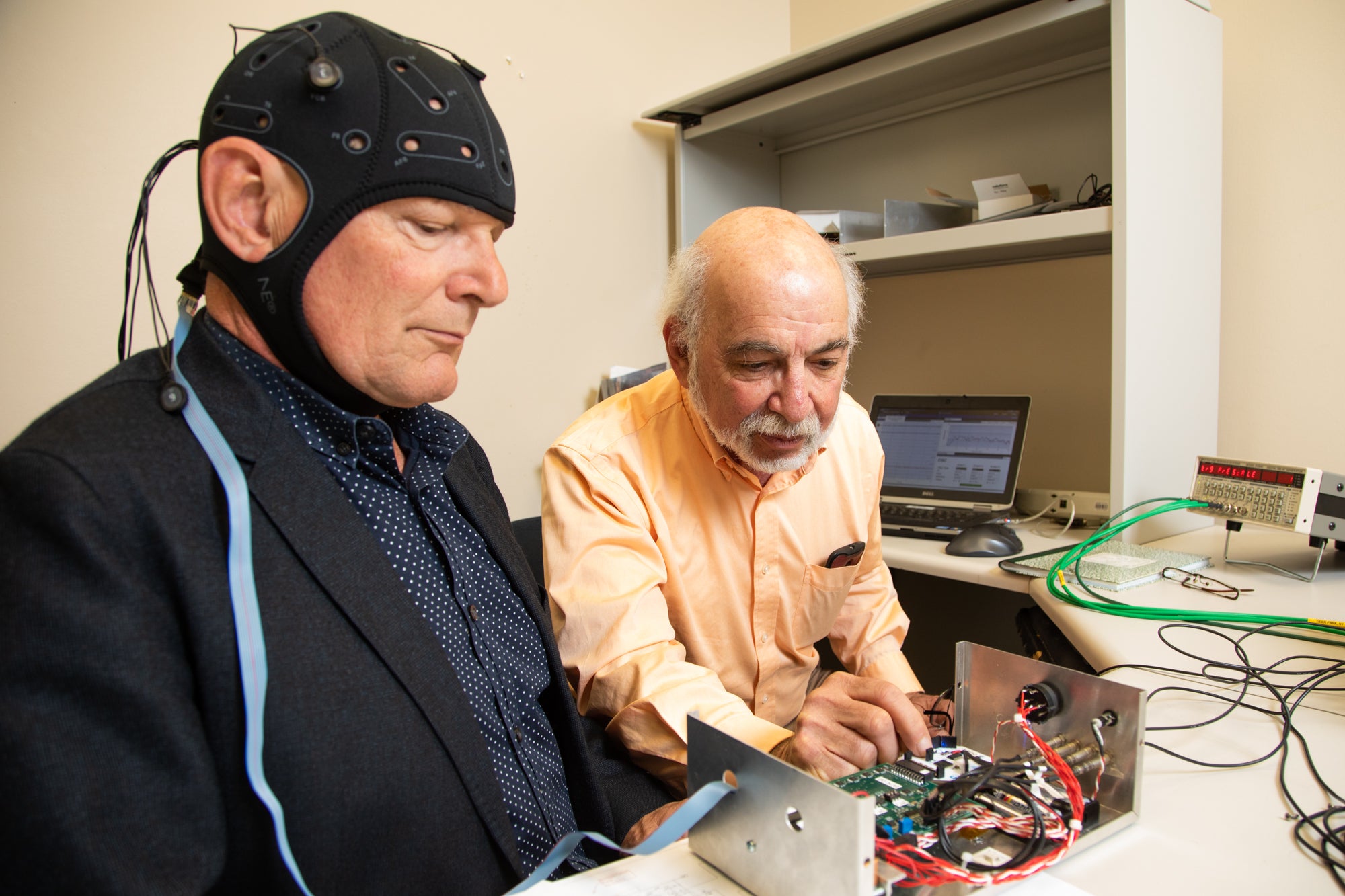Particle physicists lend a hand to advance neuroscience
After meeting at a party, a Stanford psychologist and SLAC particle physicists have collaborated on a new kind of EEG device that can stimulate the brain and read out the effects.
Psychologist Anthony Norcia had a problem. In his research untangling vision processing in the brain, he wanted to simultaneously zap the brain with electricity and measure the electrical aftereffects – two techniques commonly used to probe brain function, but never successfully combined.

Anthony Norcia, left, and Martin Breidenbach examine an electroencephalogram device built to both electrically stimulate the brain and read the signals the brain generates in response. (Image credit: Dawn Harmer Photography)
Now, Norcia, who is a research professor in psychology, is on his way toward solving that problem, with help from experimental particle physicists at SLAC National Accelerator Laboratory. The collaboration with Christopher Kenney, a senior scientist at SLAC, and Martin Breidenbach, professor emeritus of particle physics and astrophysics, has helped Norcia develop tools that could change the way researchers study the brain. It has also given Kenney and Breidenbach a chance to apply their physics skills in a new field where they might someday make a difference in people’s daily lives.
“It’s great science and you can have a societal impact,” Kenney said. “There aren’t too many things like that.”
The perfect match
At the heart of the problem is a mismatch between measuring the electrical signals generated by neurons in the brain and the electrical signals needed to stimulate those neurons. Electrical signals emanating from the brain are typically around a few microvolts, roughly a millionth of what one could get out of an AA battery. But stimulating the brain’s circuits takes a much larger electrical signal, closer to 10 volts, or what you would get out of six or seven AAs.
An EEG device that could both stimulate and measure brain activity, in other words, would have to operate over an enormous range of voltage scales, and Norcia wasn’t sure how to build such a technology.
Then one day Norcia found himself at a party when his wife, herself an experimental particle physicist, introduced him to Kenney. Kenney had been applying engineering skills gleaned from a career in particle physics to technical problems in neuroscience, and Norcia thought he might have found a way forward.
“Each side knew just enough to connect – I knew enough about electromagnetic theory,” and Kenney and his SLAC colleagues knew enough about neuroscience. “It was a match.”
Moving neuroscience tools forward
Norcia and Kenney’s meeting was about five years ago, and not long after they got seed funding from Stanford Bio-X to begin work on the project.
But scientific and engineering challenges were not the only issues they had to confront. For one thing, the researchers had to figure out how to use a Stanford seed grant to pay for people and parts at SLAC, something that had rarely been done before. (Since then, additional teams from Stanford Bio-X, Stanford ChEM-H and other institutes have successfully shared funding with SLAC collaborators.) For another, they had to set up protocols for testing their prototypes on people, another step that SLAC researchers had never dealt with.
Once those issues were solved, Kenney, Breidenbach and their colleagues dove in. Despite having zero experience with EEG, Breidenbach said, “it yields to a physics approach,” and about two years ago, the team produced their first prototype, a proof-of-concept device that could generate strong electrical stimulation while remaining sensitive to the weak signals produced in the brain.
For Norcia, that first prototype and subsequent devices, the latest of which the team is trying out this month, brings him one step closer to technologies that could dramatically improve neuroscientists’ ability to study the brain. Before, measuring the effects of electrical stimulation meant zapping the brain, then waiting minutes or hours or longer to watch for effects on a person’s behavior. Soon, Norcia said, they may be able to perform experiments and track the brain’s response directly as the stimulation occurs.
And for the SLAC researchers, it’s a chance to do something entirely new. “There are ten or twenty thousand particle physicists and dozens of experiments to do,” Kenney said. In neuroscience, that ratio is flipped, with far more experiments to do – and tools to develop – than people to do the work. “It’s much more of an open space.”
Norcia is also a member of the Maternal and Child Health Research Institute.
The research was funded by grants from the National Institutes of Health, a National Research Service Award, the European Research Council and the German Federal Ministry of Education and Research.
To read all stories about Stanford science, subscribe to the biweekly Stanford Science Digest.
